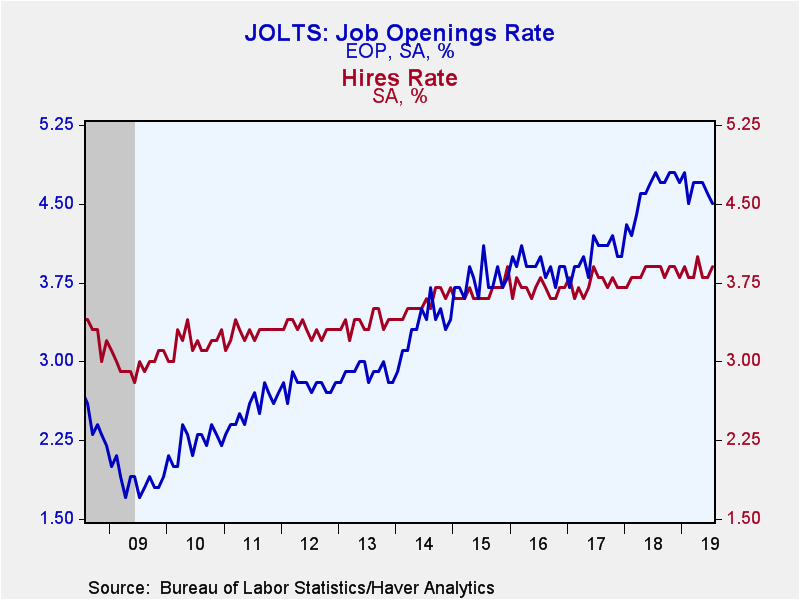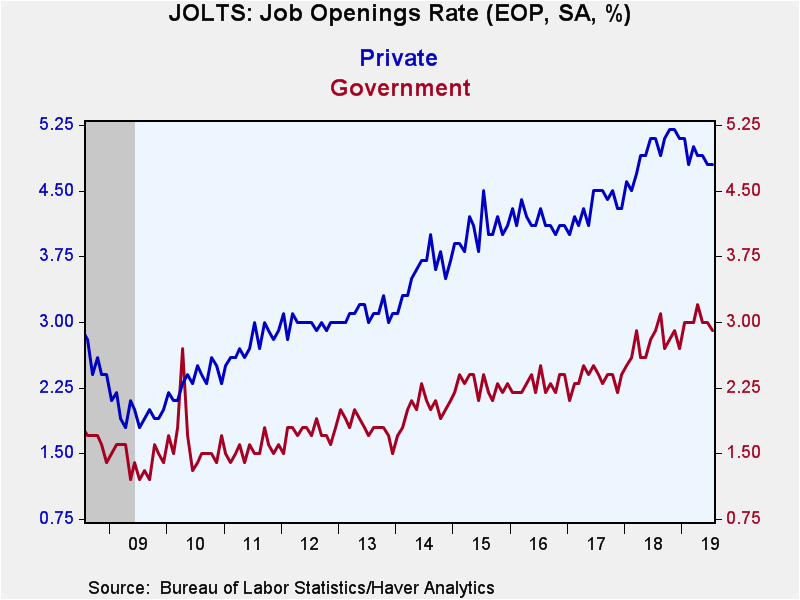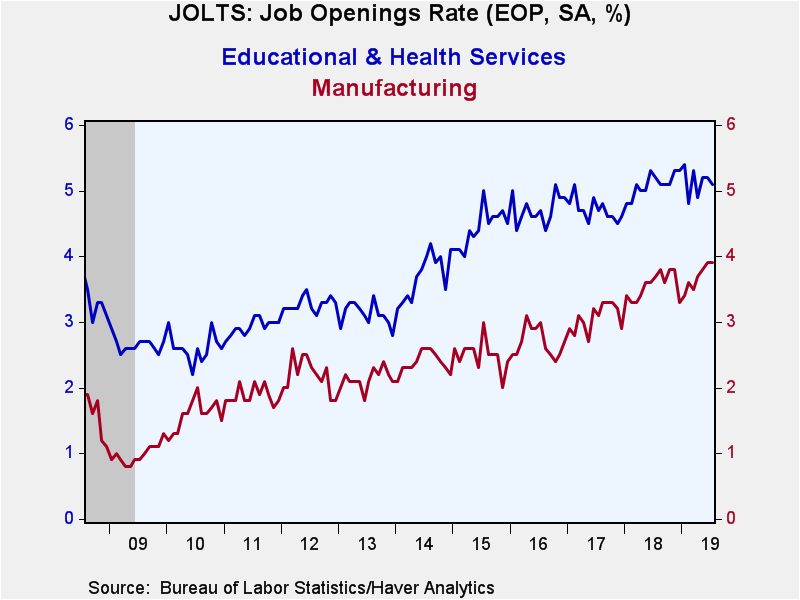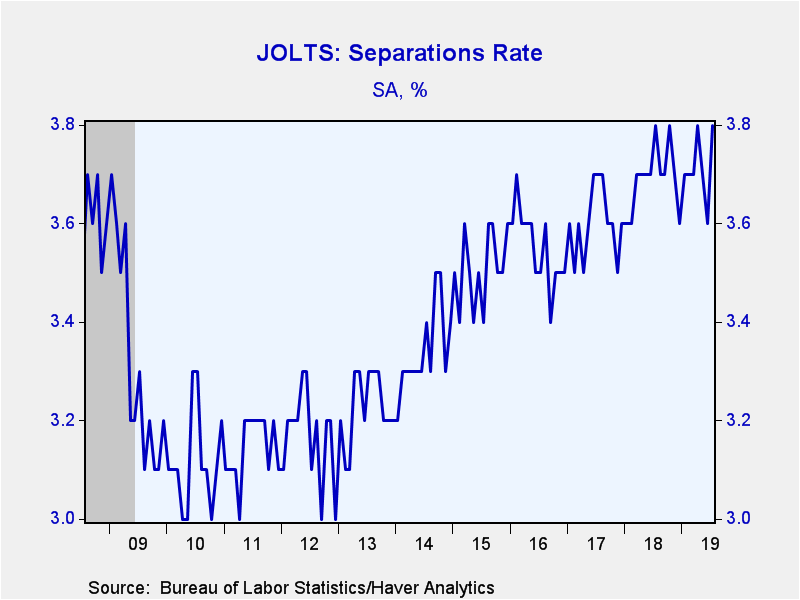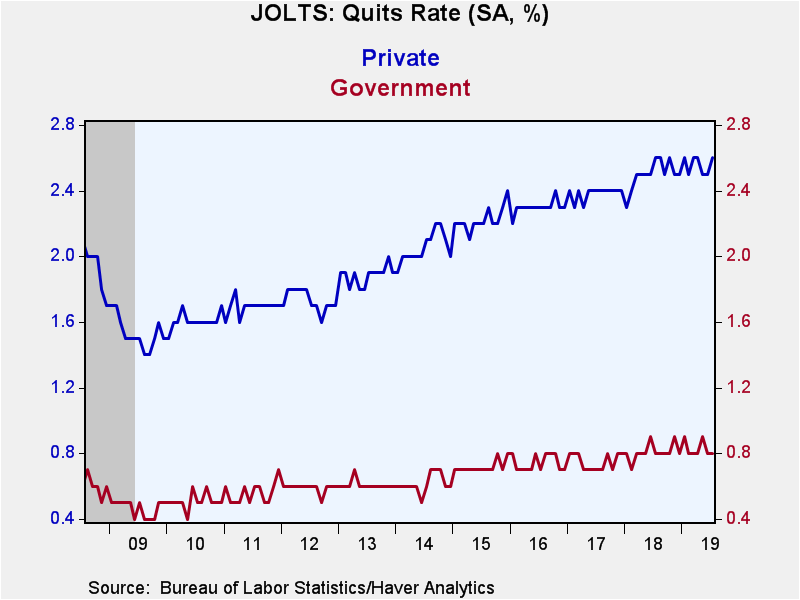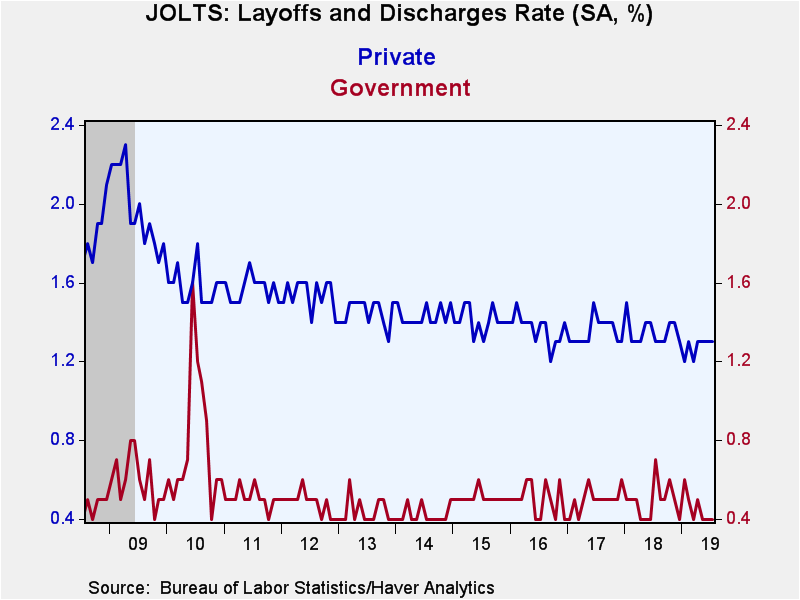 Global| Sep 10 2019
Global| Sep 10 2019U.S. JOLTS: Job Openings Rate Dips; Hiring Rate Improves
by:Tom Moeller
|in:Economy in Brief
Summary
The Bureau of Labor Statistics reported that the total job openings rate slipped to 4.5% during July from an unrevised 4.6% in June. It remained below the 4.8% record reached in January. The job openings rate is the job openings level [...]
The Bureau of Labor Statistics reported that the total job openings rate slipped to 4.5% during July from an unrevised 4.6% in June. It remained below the 4.8% record reached in January. The job openings rate is the job openings level as a percent of total employment plus the job openings level. The ability to find workers to fill openings improved as the hiring rate rose to 3.9%. It remained lower than the April peak of 4.0% and has been below the openings rate since mid-2014. Employers are still reluctant to let people go. The layoff & discharge rate ticked up m/m to 1.2%, but remained near the record low. Individuals remain ready to find new work. The quits rate rose to a near-record 2.4%.
The private-sector job openings rate also held steady m/m at 4.8%. It remained below the 5.2% record reached in November. The rate has increased from 4.6% early last year and from the 2009 average of 2.0% at the recession low. In professional & business services, the rate fell m/m to 5.5% and was below January's 6.5%. In leisure & hospitality, the rate of 5.3% was lower than December's high of 6.2%. In education & health services, the rate eased to 5.1%, still up from 2.6% in 2010. In trade, transportation & utilities, the rate eased to 4.6%. The openings rate rose slightly to 4.7% in the construction sector, still down from the record 5.5% in April. In manufacturing, the rate held at the record of 3.9%, higher than the 3.7% rate twelve months earlier. The government sector job openings rate fell to 2.9%, but remained up sharply from the 2009 low of 1.2%.
Job availability fell m/m. The level of job openings eased 0.4% (-3.0% y/y) to 7.217 million after a 1.8% June decline. It was the lowest level since February and 5.4% below the record high reached in November of last year. Private-sector openings fell 3.1% y/y while government sector job openings declined 2.4%, though they have trended higher recently.
Hiring activity improved. The private-sector hiring rate rose to 4.3% and nearly equaled April's expansion high of 4.4%. The rate in leisure & hospitality improved to 6.8%, a three-month high. In professional & business services, the hiring rate recovered to 5.6% after falling sharply during the prior two months. It nevertheless remained below the June 2017 high of 6.1%. The construction sector's hiring rate slipped m/m to 5.1%, and remained well below the high of 6.6% in December 2016. The hiring rate in trade, transportation & utilities increased to 4.3%, up sharply from the March low of 3.9%. In education & health services, the rate surged to 3.1%. That equaled the highest level since 2006, up from the 2011 low of 2.2%. In manufacturing, the hiring rate rose to 2.7%. The hiring rate in government edged up to 1.6%.
Total hiring increased 4.1% (2.1% y/y) to 5.93 million. Hiring in the private sector rose 2.8% y/y while government sector hiring declined 8.7% y/y.
Individuals were more inclined to find new work. The overall job separations rate rose to 3.8% and matched the expansion high. The private sector separations rate increased to the cycle high of 4.2%, up from the recession low of 3.4%. The separations rate in government held steady at 1.5%.
The total level of separations rose 1.5% y/y. In the private sector, the 2.6% y/y increase reflected an 2.5% y/y gain in professional & business services. In educational and health services, separations climbed 4.8% y/y, while separations in trade, transportation & utilities gained 4.7% y/y. Separations in leisure & hospitality rose 0.9% y/y. The construction sector realized a 3.8% y/y rise in separations. Working the other way, separations in manufacturing declined 10.7% y/y while separations in the government sector fell 13.7% y/y.
Confidence in finding work remains high. The level of quits rose 4.3% y/y to 3.592 million in July. The near-record quits rate of 2.4% was increased sharply from 1.3% at the beginning of the expansion. The private-sector quits rate rose slightly to 2.6%, up from 1.4% in the fall of 2009. The government sector quits rate remained low at 0.8%.
The level of layoffs declined 3.2% y/y. In the private sector, layoffs were little changed y/y. The layoff rate remained near the record at 1.3% and was down from the 2009 high of 2.2%. Layoffs declined by roughly one-third y/y in the government sector and the layoff rate was steady at 0.4%.
The Job Openings & Labor Turnover Survey (JOLTS) dates to December 2000 and the figures are available in Haver's USECON database.
| JOLTS (Job Openings & Labor Turnover Survey, SA) | July | June | May | July'18 | July'17 | July'16 |
|---|---|---|---|---|---|---|
| Job Openings, Total | ||||||
| Rate (%) | 4.5 | 4.6 | 4.7 | 4.8 | 4.1 | 4.0 |
| Total (000s) | 7,217 | 7,248 | 7,384 | 7,442 | 6,349 | 6,088 |
| Hires, Total | ||||||
| Rate (%) | 3.9 | 3.8 | 3.8 | 3.9 | 3.8 | 3.8 |
| Total (000s) | 5,953 | 5,716 | 5,760 | 5,833 | 5,510 | 5,427 |
| Layoffs & Discharges, Total | ||||||
| Rate (%) | 1.2 | 1.1 | 1.2 | 1.2 | 1.3 | 1.2 |
| Total (000s) | 1,799 | 1,711 | 1,773 | 1,859 | 1,886 | 1,777 |
| Quits, Total | ||||||
| Rate (%) | 2.4 | 2.3 | 2.3 | 2.3 | 2.1 | 2.1 |
| Total (000s) | 3,592 | 3,462 | 3,478 | 3,443 | 3,134 | 2,988 |
Tom Moeller
AuthorMore in Author Profile »Prior to joining Haver Analytics in 2000, Mr. Moeller worked as the Economist at Chancellor Capital Management from 1985 to 1999. There, he developed comprehensive economic forecasts and interpreted economic data for equity and fixed income portfolio managers. Also at Chancellor, Mr. Moeller worked as an equity analyst and was responsible for researching and rating companies in the economically sensitive automobile and housing industries for investment in Chancellor’s equity portfolio. Prior to joining Chancellor, Mr. Moeller was an Economist at Citibank from 1979 to 1984. He also analyzed pricing behavior in the metals industry for the Council on Wage and Price Stability in Washington, D.C. In 1999, Mr. Moeller received the award for most accurate forecast from the Forecasters' Club of New York. From 1990 to 1992 he was President of the New York Association for Business Economists. Mr. Moeller earned an M.B.A. in Finance from Fordham University, where he graduated in 1987. He holds a Bachelor of Arts in Economics from George Washington University.


